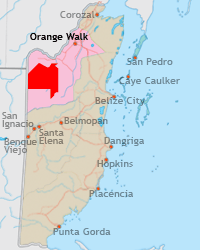By Emily Davis

Rio Bravo Conservation and Management Area in red
In June, I spent 4 weeks working on an archaelogical dig and living in the Rio Bravo Conservation and Management Area (RBCMA), a protected area of (now) 260,000 acres in northwestern Belize. First a bit of history, Belize, formerly British Honduras, became independent in 1981. The all-volunteer Belize Audubon society was charged with caring for the national parks, and in 1984, reached out to the Massachusetts Audubon Society. Mass Audubon formed a nonprofit Belizean organization, Programme for Belize (PfB), to protect the more than 150,000 acres that had been donated or purchased at that time. Besides being home to jaguars, howler monkeys and about 260 species of birds (many of which spend part of the year in Massachusetts), RBCMA also has about 60 Mayan Archeological sites.
During my first night, howler monkeys woke me up at 11:30pm, then around 3am and then finally at 5am. Since breakfast was served at 6 am, I figured I wouldn’t need an alarm. I was wrong. Howlers howl mostly during the day and never did again at 5am. That first night they were just upset by the invasion of us humans. The spider monkeys showed their rage at us by throwing things. Both species became accustomed to our presence in a day or so and went about their normal business. During most of my visit, the camp had around 125 occupants. Some of us slept in bunk beds in a dormitory, others in tents. We ate in 2 shifts in a screened in dining hall, shared 4 cold showers, and used pit toilets. While the accommodations were simple, the locale could have earned 5 stars. We were living and working in the midst of a beautiful old-growth forest and visits by forest residents always caught our attention.
Leaf cutter ant path
One of the residents that fascinated me most were the leaf cutter ants. I had no idea that ants could create such wide paths across a lawn. There were two sets of ant “highways” in this lawn – one group of ants carried pieces of leaves, as I had seen many times, but the other was carrying pieces of orange and red flowers from a flame tree. Other regular visitors include coati mundis, gray foxes, kiskadees and an oscillated turkey who seemed to be keeping track of us. I knew that it takes around 200 years for a forest community to mature, but I learned some of the features that a forest needs to have to be old growth: the 3 dimensional structure is complicated – trees are leaning or have fallen down; the lianas are large; and the tree species in the canopy are also in the understory showing that the trees are reproducing.
When I returned people asked me what I found. I’ll have to say it will not seem very exciting. I knew we were investigating a commoner site so my goal was to find pottery shards – I did. But it turns out that the best thing I found was charcoal. Apparently charcoal is datable so my find will help determine the dates that the site was occupied.
Emily is a happy retiree who spends time volunteering with the Sierra Club's Plastics and Ready for 100 campaigns. She also finds time to row on the Schuylkill, tends a plot in a community garden that is part of the City Harvest program providing food to underserved communities, and she volunteers in the Botany Department at the Academy of Natural Sciences.